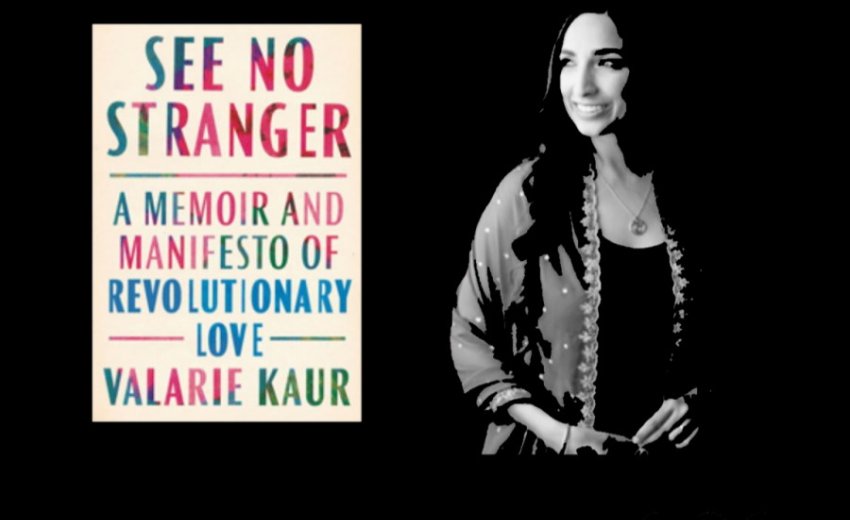Reflections on Valarie Kaur’s 'See No Stranger:
A Memoir & Manifesto to Revolutionary Love'
by Raj Kaur
________________________________________________________________________________________
“The future is dark. But is this the darkness of the tomb – or the darkness of the womb?”
How do we labor for the world we want when the labor feels endless? Valarie Kaur – renowned Sikh activist, filmmaker, and civil rights lawyer – declares that revolutionary love is the call of our time, a radical, joyful practice that extends in three directions: to others, to our opponents, and to ourselves. It enjoins us to see no stranger but instead look at others and say: You are a part of me I do not yet know. Starting from that place of wonder, the world begins to change: It is a practice that can transform a relationship, a community, a culture, even a nation.
Kaur takes readers through her own riveting journey – (source ...)
_____________________________________________________________________________________________________________
Do you feel it? A heaviness, exhaustion, breathlessness, as the world seems to increasing spiral into hate, injustice, and intolerance. Yet within the turmoil and darkness we can also find something else. Glimpses of resiliency and hope, moments where humanity stands hand-in-hand to push forth a better world for all. Valarie Kaur asks us: is this the darkness of the tomb or the darkness of the womb?
In her new book, Valarie Kaur takes us on a remarkable journey starting with her life living on a farm in America and her Sikhi upbringing, to the aftermath of 9/11 including a sharp rise in hate crimes including the murder of Balbir Singh and the Oak Creek Gurdwara massacre. The book speaks to the ongoing sentiments of exclusion, racism, and violence plaguing America and the world at large today.
Within all this, Valarie shares her experiences, both personal and political, and wisdom on how to love others, our opponents, and ourselves: how to perform the sweet labor of love required to bring about change, how to grieve, fight, and re-imagine together in community. Can we do it? With the chaos whirling around us, and so many factions of our world becoming more divided, will we let this continue, or will we dive into the pockets of revolutionary love occurring around us, and forge a better world, together?
My top 3 takeaway from “See No Stranger”
I found an enriching personal connection with Valarie’s book. As soon as I opened the book, I was captivated. Within each page you’ll read about struggle, trauma both personal and collective, and also strength, inspiration, and perseverance. I wasn’t expecting this book to be such a powerful read, and to be taken through a whirlwind of emotions from wonder to hope, from joy to despair, and back again. Reading this book was a transformative experience for me, and below I will highlight my top 3 takeaways from it.
1. What does it mean to ‘see no stranger?’
In the 1500s, Guru Arjan Sahib revealed a shabad (Ang 1299) where he described letting go of his jealousy, how he views no one as his enemy and sees no one as a stranger:
ਕਾਨੜਾ ਮਹਲਾ ੫ ॥
kaanaRaa mahalaa panjavaa ||
Kaanraa, Fifth Mehla:
ਬਿਸਰਿ ਗਈ ਸਭ ਤਾਤਿ ਪਰਾਈ ॥
bisar giee sabh taat paraiee ||
I have totally forgotten my jealousy of others,
ਜਬ ਤੇ ਸਾਧਸੰਗਤਿ ਮੋਹਿ ਪਾਈ ॥੧॥ ਰਹਾਉ ॥
jab te saadhasa(n)gat moh paiee ||1|| rahaau ||
since I found the Saadh Sangat, the fellowship of Truth seekers. ||1||Pause||
ਨਾ ਕੋ ਬੈਰੀ ਨਹੀ ਬਿਗਾਨਾ ਸਗਲ ਸੰਗਿ ਹਮ ਕਉ ਬਨਿ ਆਈ ॥੧॥
naa ko bairee nahee bigaanaa sagal sa(n)g ham kau ban aaiee ||1||
No one is my enemy, and no one is a stranger. I get along with everyone. ||1||
ਜੋ ਪ੍ਰਭ ਕੀਨੋ ਸੋ ਭਲ ਮਾਨਿਓ ਏਹ ਸੁਮਤਿ ਸਾਧੂ ਤੇ ਪਾਈ ॥੨॥
jo prabh keeno so bhal maanio eh sumat saadhoo te paiee ||2||
Whatever Waheguru does, I accept that as good. This is the sublime wisdom I have obtained from the Holy. ||2||
ਸਭ ਮਹਿ ਰਵਿ ਰਹਿਆ ਪ੍ਰਭੁ ਏਕੈ ਪੇਖਿ ਪੇਖਿ ਨਾਨਕ ਬਿਗਸਾਈ ॥੩॥੮॥
sabh meh rav rahiaa prabh ekai pekh pekh naanak bigasaiee ||3||8||
Ik Onkar is pervading in all. Gazing upon the Divine, beholding Divine, Nanak blossoms forth in happiness. ||3||8||
Valarie explores this notion. As she eloquently explains, to “see no stranger” means to cultivate and embrace a sense of curiosity, of wonder, for all around us. It’s about being present and courageous, and opening the mind to listen to and understand the stories of others. When we allow ourselves to wonder, we become receptive to other perspectives, suspend judgement, and quieten our own internal biases. Here we find the roots of empathy and love. We see the inherent connection between all, each of us a part of the whole.
This type of approach can help strengthen relationships with others, comprehend the plight of those who are suffering, and even help us understand why our opponents act as they do. Through deeper understanding, we begin realizing the root causes of issues – whether in our personal relationships, or society at large – we then become better positioned to develop effective solutions to those issues that perpetuate conflict and inequality. As Valarie explains, “I focus not only on fighting my opponents but reimagining and remaking institutions and cultures that can free all of us.”
I’m reminded of the following beautiful Shabad revealed to Bhagat Kabir on Ang 1367:
ਕਬੀਰ ਹਰਦੀ ਪੀਅਰੀ ਚੂੰਨਾਂ ਊਜਲ ਭਾਇ ॥
kabeer haradhee peearee choo(n)naa(n) uoojal bhai ||
Kabeer, tumeric is yelow, and lime is white.
ਰਾਮ ਸਨੇਹੀ ਤਉ ਮਿਲੈ ਦੋਨਉ ਬਰਨ ਗਵਾਇ ॥੫੬॥
raam sanehee tau milai dhonau baran gavai ||56||
You shall meet the Beloved Divine, only when both colors are lost. ||56||
ਕਬੀਰ ਹਰਦੀ ਪੀਰਤਨੁ ਹਰੈ ਚੂਨ ਚਿਹਨੁ ਨ ਰਹਾਇ ॥
kabeer haradhee peeratan harai choon chihan na rahai ||
Kabeer, tumeric has lost its yellow color, and no trace of lime’s whiteness remains.
ਬਲਿਹਾਰੀ ਇਹ ਪ੍ਰੀਤਿ ਕਉ ਜਿਹ ਜਾਤਿ ਬਰਨੁ ਕੁਲੁ ਜਾਇ ॥੫੭॥
balihaaree ieh preet kau jeh jaat baran kul jai ||57||
I am a sacrifice to this love, by which social class and status, color and ancestry are taken away. ||57||
This Shabad says to me “see no stranger.” I find a connection between the Shabad and Valarie Kaur’s message of revolutionary love. When we perform the sweet labour of love for all, when the “colours” are lost, then the constructs that are used to divide humanity fade away. We see Oneness, we see no stranger. (continued....)

